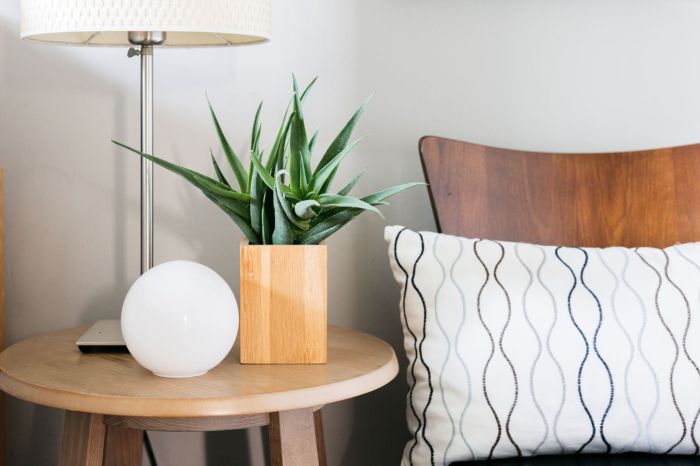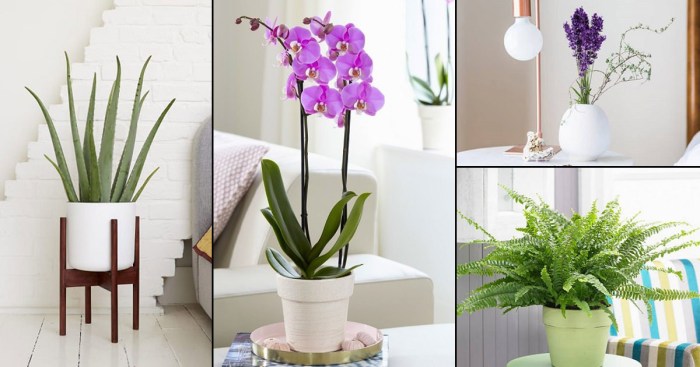Best plants to keep in bedroom – Discover the best plants to keep in the bedroom for improved air quality, reduced stress, and enhanced sleep. Explore our curated list of plants that purify the air, creating a serene and healthy sanctuary for a restful night’s slumber.
When selecting plants for the bedroom, consider factors like light requirements, size, and toxicity. Choose low-maintenance plants that thrive in low-light conditions and small spaces, ensuring a harmonious balance between nature and your personal space.
Benefits of Plants in the Bedroom

Incorporating plants into your bedroom décor can bring a plethora of health benefits. Studies have shown that the presence of plants in the bedroom can significantly improve air quality by removing harmful toxins and pollutants. Additionally, plants can help reduce stress levels, promote relaxation, and enhance sleep quality.
Specific Air-Purifying Plants
Certain plants are particularly renowned for their air-purifying capabilities. Some of the most effective include:
- Snake Plant: Known for its ability to remove formaldehyde and benzene from the air.
- Spider Plant: Effective in removing carbon monoxide and formaldehyde.
- Peace Lily: Removes benzene, trichloroethylene, and ammonia from the air.
- Golden Pothos: Effective in removing formaldehyde, xylene, and toluene.
- English Ivy: Removes formaldehyde, benzene, and trichloroethylene from the air.
Considerations for Choosing Plants for the Bedroom

When selecting plants for the bedroom, several factors should be taken into account to ensure they thrive and enhance the space’s ambiance.
Light Requirements:Consider the amount of natural light your bedroom receives. Plants that require low light, such as snake plants, ZZ plants, and peace lilies, are ideal for rooms with limited sunlight. For brighter rooms, choose plants like succulents, cacti, and spider plants.
Size and Space
The size of the bedroom and available space should influence plant selection. Choose smaller plants for cramped quarters, such as air plants, succulents, or ferns. For larger rooms, opt for taller plants like fiddle-leaf figs, palms, or rubber trees.
When selecting the best plants to keep in your bedroom, it’s crucial to consider their susceptibility to common plant problems. Spots on Plant: A Comprehensive Guide to Identification Prevention and Treatment provides valuable insights into identifying and addressing these issues.
By understanding the causes and symptoms of various plant spots, you can effectively prevent and treat them, ensuring the health and beauty of your bedroom plants.
Toxicity
Ensure that the plants you select are non-toxic to humans and pets. Avoid plants like lilies, oleanders, and azaleas, which can be harmful if ingested.
Top Plants for the Bedroom

Introducing greenery into the bedroom can enhance air quality, promote relaxation, and even improve sleep. However, choosing the right plants for this intimate space requires consideration of factors such as light availability, toxicity, and air-purifying abilities.
Among the best plants to keep in the bedroom are those that purify the air and promote relaxation. Real hanging plants , such as spider plants and pothos, are particularly effective at removing toxins from the air and adding a touch of greenery to the room.
These plants also require minimal care, making them an excellent choice for busy individuals.
To assist in your selection, we have compiled a table comparing four popular plants suitable for the bedroom. Each entry provides details on light requirements, toxicity, and air-purifying qualities, along with a brief description highlighting unique features and benefits.
Comparison of Bedroom-Friendly Plants
| Plant Name | Light Requirements | Toxicity | Air-Purifying Qualities |
|---|---|---|---|
| Snake Plant | Low to bright indirect light | Non-toxic to pets | Removes formaldehyde, benzene, trichloroethylene, and xylene |
| Peace Lily | Low to medium indirect light | Toxic to pets (ingestion can cause oral irritation) | Filters formaldehyde, benzene, trichloroethylene, and ammonia |
| Spider Plant | Low to bright indirect light | Non-toxic to pets | Purifies air by removing formaldehyde, xylene, and toluene |
| Lavender | Bright indirect light | Toxic to pets (ingestion can cause vomiting, diarrhea) | Promotes relaxation and sleep; removes formaldehyde and benzene |
Caring for Plants in the Bedroom
Maintaining the health and vitality of plants in the bedroom requires proper care and attention. Basic care involves watering, fertilizing, and pruning, each of which plays a crucial role in ensuring optimal plant growth and well-being.
Watering, Best plants to keep in bedroom
The frequency of watering depends on the plant species, pot size, and room temperature. As a general rule, plants should be watered when the top inch or two of soil feels dry to the touch. Overwatering can lead to root rot, while underwatering can cause wilting and stunted growth.
Fertilizing
Fertilizing provides plants with essential nutrients for healthy growth. Slow-release fertilizers are recommended for bedroom plants, as they release nutrients gradually over time. Fertilize plants monthly during the growing season (spring and summer) and less frequently during the dormant season (fall and winter).
Pruning
Pruning involves removing dead, diseased, or overgrown stems and leaves. Regular pruning promotes healthy growth, improves air circulation, and enhances the plant’s appearance. Use sharp, clean pruning shears to make precise cuts and avoid damaging the plant.
Additional Tips for Enhancing the Bedroom with Plants

Incorporating plants into your bedroom décor can not only purify the air and improve your sleep but also create a serene and inviting atmosphere. Here are some additional tips to help you make the most of plants in your bedroom:
Incorporate Plants into Your Décor
There are many creative ways to incorporate plants into your bedroom décor. You can hang planters from the ceiling, create a plant wall, or place plants on nightstands, dressers, and windowsills. You can also use plants to add color and texture to your bedding, curtains, and other textiles.
From the lush greenery of snake plants to the delicate blooms of orchids, choosing the best plants for your bedroom can enhance both your sleep and decor. For a comprehensive guide to indoor plants and home styling, explore Discover the Allure of Indoor Plant Stores: A Guide to Greenery and Decor . This resource offers expert tips on selecting the ideal plants for your bedroom, ensuring a restful night’s sleep amidst the beauty of nature.
Choose Plants that Complement Your Bedroom
When choosing plants for your bedroom, it’s important to consider the overall aesthetic of the room. If you have a modern bedroom, you might want to choose plants with clean lines and simple shapes. If you have a more traditional bedroom, you might want to choose plants with more ornate leaves and flowers.
For a peaceful and rejuvenating bedroom, consider incorporating plants that purify the air and create a calming ambiance. One standout choice is the Ribbon Fern, an enduring beauty that unveils its charm with delicate, ribbon-like fronds. Its air-purifying qualities make it an ideal companion for bedrooms, promoting restful sleep and a healthier indoor environment.
Last Word: Best Plants To Keep In Bedroom
Incorporating plants into the bedroom décor adds a touch of tranquility and beauty. Hang planters from the ceiling, create a living wall, or place plants on nightstands to create a lush and inviting atmosphere. Choose plants that complement the bedroom’s color scheme and overall aesthetic, enhancing both the visual appeal and the well-being of your personal sanctuary.
Questions and Answers
How often should I water plants in the bedroom?
Water plants when the soil feels dry to the touch, typically once or twice a week, depending on the plant species and humidity levels.
Are there any toxic plants to avoid in the bedroom?
Yes, avoid plants like lilies, oleander, and azaleas, which can be toxic to pets and humans if ingested.
Can plants help improve sleep quality?
Certain plants, such as lavender and jasmine, release calming scents that promote relaxation and sleep.